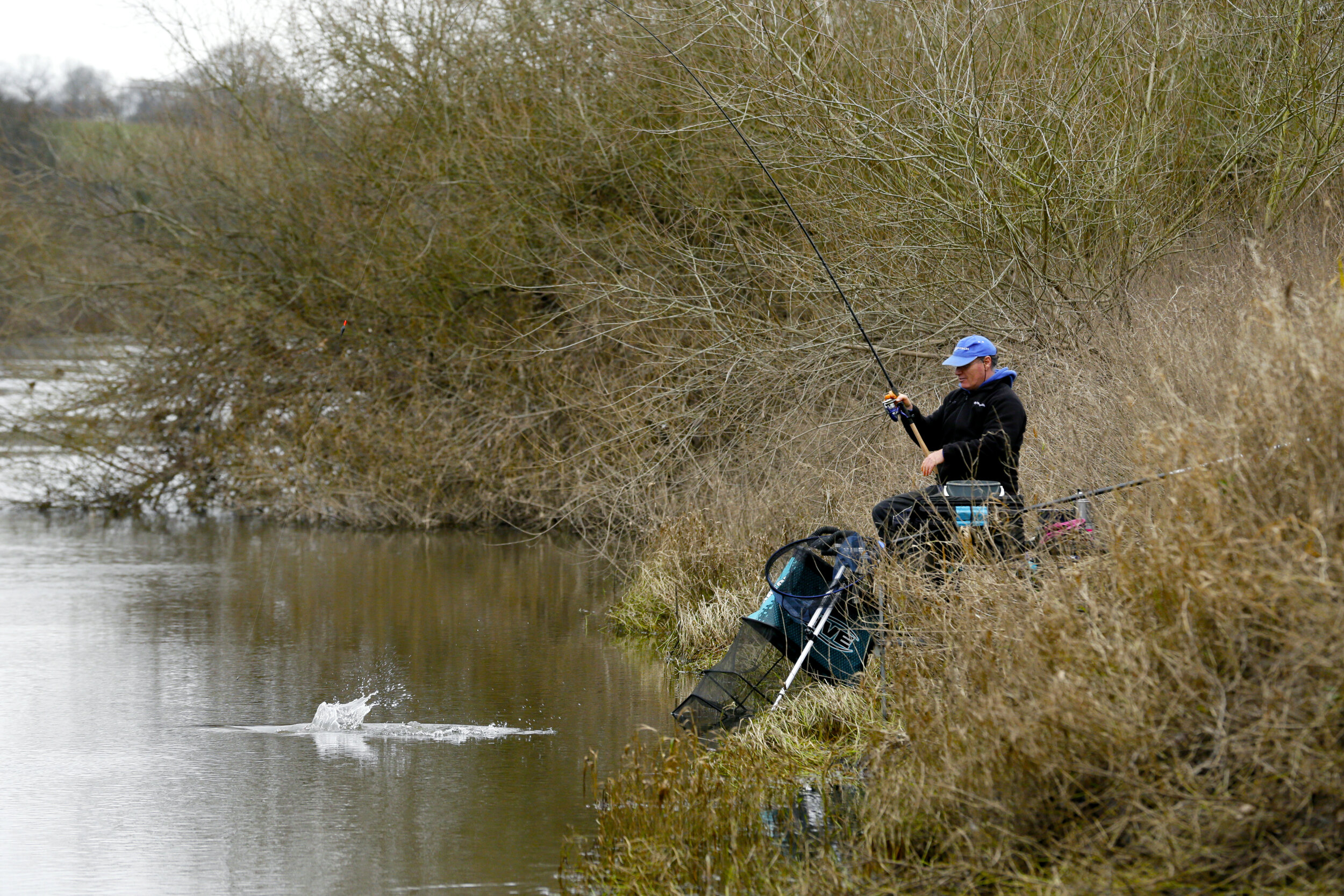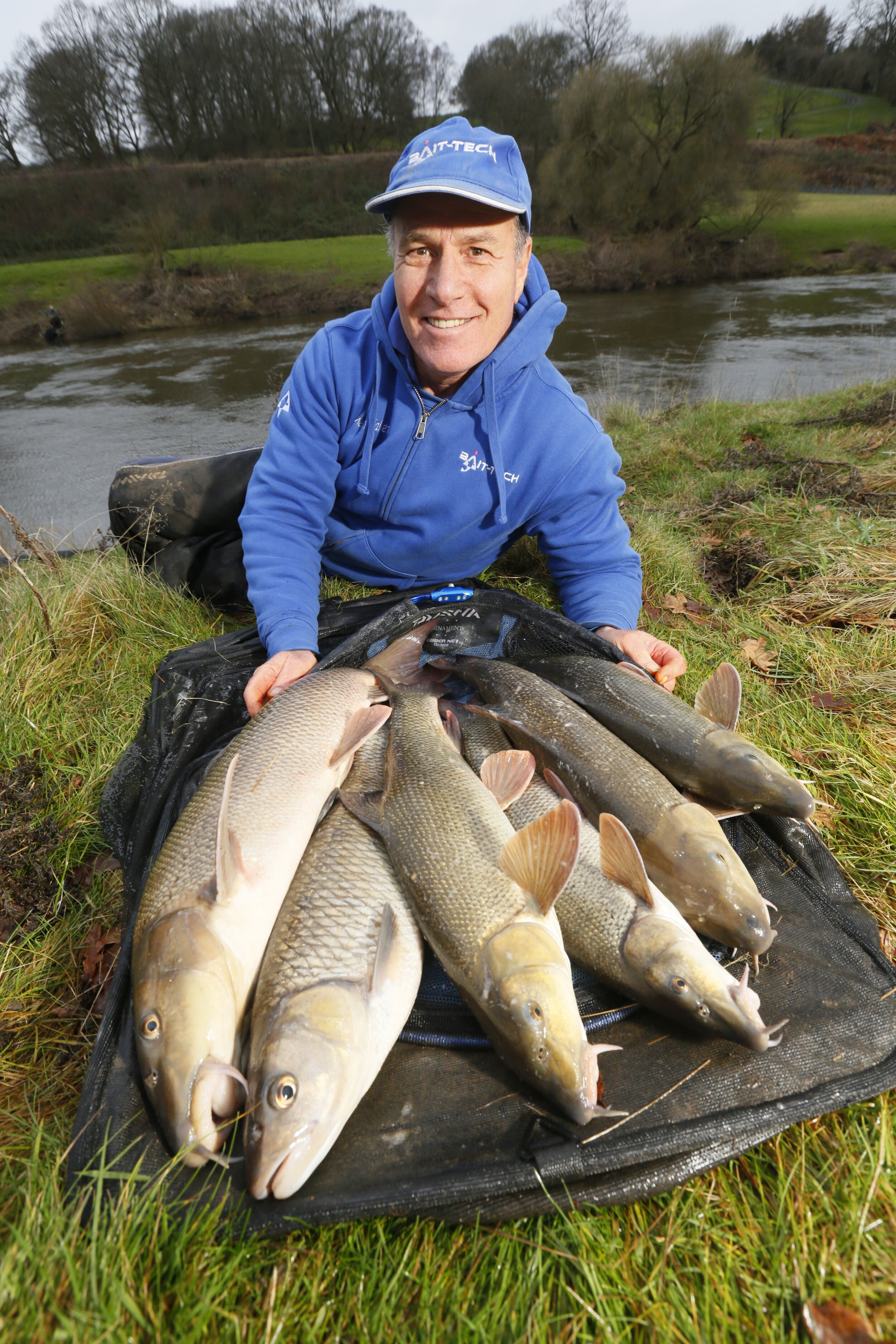River Fishing Tips | Running or fixed feeder for chub? - Hadrian Whittle
My rig actually works on both principles – it’s a hybrid of a running and fixed set-up. The feeder slides on the line and is stopped above a short length of twisted line via a float stop or bead.
The black-cap feeder rig
Above the feeder is another stop that can be slid up and down to increase or decrease the gap between the stops and, thus, how far the feeder can move.
By leaving just an inch gap and having the feeder balanced to just hold bottom, anything taking the bait moves the feeder, which then hits the stop and helps to hook the fish.
There are days when lengthening this gap works, others when shortening it right up catches more.
A cracking river chub
River Fishing Tips | The best method for early season chub - James Champkin
This may sound crazy, but my number one method for early season chub is to use lures!
I was introduced to it a few years ago, and it’s the most exhilarating style of chub fishing I’ve ever done.
I use small (5cm-7cm) floating crankbaits and work them slowly down the flow, with the rod tip held high, so that the lure wiggles enticingly on the surface.
Lures with a fat body and a large rattle work well, but I’ve also been experimenting with insect imitations, which have proved deadly.
Cast long upstream and try to work your lure close to any overhanging trees. Stay alert - takes can be explosive!
Chub love to hit lures!
River Fishing Tips | Six tricks to catch the bigger river fish - Darren Cox
Hungry as the big specimens may be, the appetites of their smaller brethren will be just as keen, and a day can be soured by a never-ending stream of tiddlers and nothing substantial to put a bend in the rod.
On a river, it’s not that easy to single out the chub and bream when there are hordes of tiny bleak and dace to wade through. You will have to put up with catching some of these smaller fish, because that’s just the way it is, but there are plenty of tricks you can try to sort out the proper big boys!
“It’s not that easy to single out the chub and bream when there are hordes of tiny bleak”
Find the fast water
Find swims with faster water that will be well-oxygenated. Most species will have finished spawning and will move into gravel runs in fast water. You’ll still find little fish there, but that’s where the chub will be.
Fast well-oxygenated water is best for big fish early in the season
Use big baits
Maggots will be a waste of time. Casters are a favourite and tend to sort out the chub and big roach. If you’re still getting pestered by bleak and dace, though, use tares or a kernel of corn.
Bigger baits for bigger fish - don’t waste time with maggots!
Tackle up properly!
Big hooks and stronger lines will make sure you land chub and even barbel and will also put the smaller fish off. Try a size 16 hook to a 0.12mm or 0.14mm hooklength.
Use bigger hooks and stronger line
Up the feed
Feed hemp and caster in a ratio of 50/50. Begin by feeding sensibly to work out how many bigger fish are there. If small fish are a problem, double the feed.
Keep the feed going in and double the ratio if small fish are becoming a problem.
Go shallow
Fish will be very active in early season and may be feeding off bottom. This is especially true of chub. A small stumpy waggler fished at half-depth is a super way to catch chub darting about up in the water.
Try a small waggler fished at half-depth for chub
Fishmeal groundbait
Bream are the main target on slower rivers, but even on the feeder, little fish can dominate. Use a fishmeal groundbait, which dace and roach aren’t so keen on. Add inert particles like hemp and casters.
Fishmeal groundbait is a great attractor for big bream
River Fishing Tips | When to swap the bomb to the feeder for chub - Phil Spinks
The feeder comes into play on rivers that are running slightly clear, and bread is an excellent bait for these conditions.
A medium Drennan Cage feeder packed with liquidised bread works well, using breadflake on the hook.
I search the swim using this approach, having 15 minutes with one cast across to any far-bank trees and then another quarter-of-an-hour closer in where there’s slower water or down the middle of the river.
Generally, if I haven’t had a bite after around 30 minutes, I’ll make my move to the next swim along
I find legering works best in coloured water or when fishing after dark.
Try using a smelly bait like cheesepaste on a link leger taking a couple of SSG shot, or a very light 10g flat bomb that will be rolled around the bottom by the current before finally settling.
River Fishing Tips | Tame the Severn on float and feeder with Kelvin Tallett
We are all guilty of falling into lazy habits with our fishing, simply setting up one rod and waiting for a bite – but when targeting winter chub and barbel on the river this isn’t always the right way to go.
It’s very rare that you can lob out a feeder and catch steadily all day, as you can in summer, but by alternating between the feeder and the float you can stay one step ahead of the fish, and catch a lot more in the process.
I discovered this during a recent session on the River Severn at Arley, Worcestershire, where regularly changing my tactics resulted in a cracking bag.
Meaty Maggots
The only bait I took with me was a gallon of bronze maggots, with a few reds mixed in. I know that these are great for winter chub and barbel – the key to success would be to discover the right tactic for the day in question.
I’m a big fan of boosting my maggot hookbaits, and one of my favourite additives is Bait-Tech’s Sizzling Spicy Sausage glug. After riddling the maggots off, I’ll add a decent spoonful of flavouring to every few pints of grubs, before tying them up and leaving them in a bag overnight.
This gives the flavouring time to soak into the bait, but the biggest advantage, I find, of doing this is that it makes the maggots wriggle more in the cold, which in turn makes them more enticing to the fish. Although not everyone is convinced by glugs and additives, in my experience they really do work, so I would recommend giving them a go.
Starting on the Stick
I arrived at the river to find it running a foot above normal level with a decent colour. Combined with mild and overcast weather, I was hopeful of a few bites.
I sat in a typical Severn swim – long and open, with 500 yards of river visible downstream.
A hundred yards down the peg the riverbed shallowed slightly, and it’s an area where I knew the fish love to sit in summer. In the colder months, though, they move into the deeper water, which is where I would be focusing my attack today.
Setting up a stick float, a Bolo float and a maggot feeder, I started on the stick just to get a feel for things, feeding two half-pouches of maggots every run down.
You may be wondering why I didn’t just feed one big pouch, but feeding smaller amounts more regularly keeps a steady stream of bait flowing through the peg. This really gets the fish competing.
After an hour’s fishing I hadn’t received a bite, which was slightly unusual, but I wasn’t too worried – I simply reached for the feeder rod instead.
Feeder Success
Five quick casts put a bit of bait down in a specific area of the swim, and 20 minutes later the tip bounced round and I was into a hard-fighting fish.
A good barbel was netted shortly after that, and over the next half-hour I put two more barbel in the net, the bigger of which was a clonking fish close to 10lb.
Following this burst of activity, the swim went through a 30-minute lull and I suspected that the fish had dropped downstream.
I responded to this change by picking up my rod with a Bolo float attached. With this set-up I was able to follow the shoal as it moved gradually further down the peg.
Bolo Bagging
After feeding a few more pouches of bait I swung the Bolo out, and shortly after that the float tip plunged beneath the surface.
Another barbel was the culprit, and over the final hour it was followed by one more of its mates, as well as a bonus chub.
Eventually the fish backed off further and further downstream and it became increasingly difficult to keep in touch, so we decided to call it a day.
Had I not set up the Bolo rig the action would have come to a much swifter conclusion, and I would have gone home having caught just a few early fish on the feeder.
Pulling out the keepnet, I reckon I had around 30lb, all taken in just over three hours’ fishing. I’m sure that without the choice of tactics, my final tally would have been around half that weight, whereas by switching between the float and feeder I was able to stay in touch with the shoal.
There’s no doubt that you will still catch by just setting up a single rod, but next time you go out on the river make the effort to give yourself a few options – it could just result in a session you won’t forget in a hurry!
Kelvin’s Tackle
Rods: 13ft Daiwa RS Power Waggler, 12ft/13ft Daiwa RS Power Feeder
Reels: Daiwa TDR 3012
Line: DH Angling Pro Float 6lb, DH Angling Pro Feeder 8lb
Hooks: Drennan Wide Gape size 12
Floats: DH number 2 Heavy Base stick 8x4, DH number 2 Bolo 4g
Feeder: 60g Nisa Block End

















